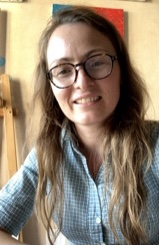Kalina Haas winner of an ERC Starting Grant with the STORMtheWALL project
Kalina Haas has recently joined the "Primary Cell Wall" (PAR) team at the IJPB, as a Research Scientist ("Chargée de recherche"). With her background in physics and quantitative biology in neurosciences, she brings in unique and complementary skills in optics, the use of biosensors and computational modeling. Her 5-year ERC Young Investigator Starting Grant entitled “STORMtheWALL” will provide funding for the recruitment of a team and the acquisition of next generation super-resolution microscopy equipment.
STORMtheWALL Project
How plants grow constitutes a major frontier in plant research.
Growth is a multi-scale process; at a subcellular scale, it depends on the expansion of the cell walls, which involves changes in the chemistry and architecture of constituent polymer networks. Little is known on the nature and the control of the cell wall changes that are critical for growth, in striking contrast to the, often detailed, knowledge of growth-regulating signaling networks. This is in part due to the lack of appropriate tools to study changes in the complex cell wall polymer assemblies that often occur at fast (~s) and small (<micrometer) scales.
STORMtheWALL firstly aims to breach the spatial limits of the tools by using multi-target optical nanoscopy to visualize cell wall architecture and remodeling, and secondly, to overcome their temporal limits by using light-gated actuators and multiplexed intracellular biosensors to simultaneously perturb and monitor the system dynamics in vivo. In particular, this project will address pectin remodeling, the role of which in plant growth was shown to be critical, but without clearly understanding the mechanism.
STORMtheWALL will provide an essential framework, not only for understanding plant growth and morphogenesis but also for the study of life beyond the plasma membrane, for instance in relation to immunity, multicellularity, or symbiosis.
Perspectives
This project will open a new dimension for the nanoscale understanding of the cell wall and unravel a novel pectin-based mechanism of its active reorganization. STORMtheWALL will provide realistic models for plant cell wall architecture. Such models are an essential brick in multiscale models predicting crop growth and yield in changing environments.
|
Plant cell wall and growth, to know more about it |

Kalina Haas mini-CV
2021 - Permanent position at IJPB, INRAE, Versailles, as Research scientist. She developped the topic "From wall nanostructure to signaling and growth in plants"
2020 - INRAE ERC tenure track researcher, IJPB, INRAE, Versailles
2019 - Post-doctoral position, IJPB, INRAE, Versailles
2018 - Post-doctoral position, University Paris Diderot, Paris University today
2013 - Post-doctoral position, on DNA damage repair and developed strategies for multiplexed biosensing, Hutchison Cancer Unit, Cambridge University
2013 - PhD, has studied the molecular organization of synapses using super-resolution microscopy, University of Bordeaux 2010 - Master's degree in physics, University of Warsaw, Poland
Back

B: Lobed leaf epidermal anticlinal (normal to the surface) cell wall imaged with 3D dSTORM super-resolution*, with methylated (pink) and fully demethylated (green) pectin homogalacturonan (HG) C: partially methylated (pink) and fully demethylated (green) HG.
* dSTORM is a super-resolution fluorescence microscopy method, based on single molecule localisation
Breakthrough in 2020,
the cell wall is acting to define the cell shape, news 27/01/2020